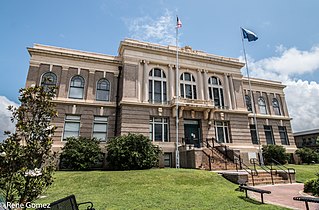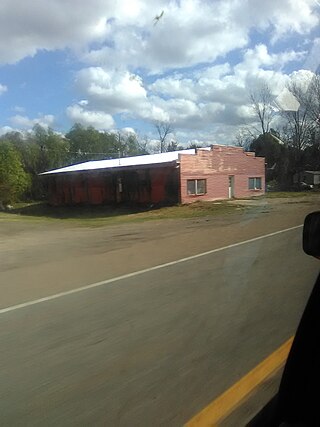
Natchitoches Parish is a parish located in the U.S. state of Louisiana. As of the 2020 census, the population was 37,515. The parish seat is Natchitoches. The parish was formed in 1805.

DeSoto Parish is a parish located in the U.S. state of Louisiana. The parish was formed in 1843. At the 2020 U.S. census, the population was 26,812. Its parish seat is Mansfield. DeSoto Parish is part of the Shreveport–Bossier City metropolitan statistical area.

Natchez is a village in Natchitoches Parish, Louisiana, United States. The population was 597 at the 2010 census. It is part of the Natchitoches Micropolitan Statistical Area. The village and parish are part of the Cane River National Heritage Area.

Natchitoches is a small city and the parish seat of Natchitoches Parish, Louisiana, United States. Established in 1714 by Louis Juchereau de St. Denis as part of French Louisiana, the community was named after the indigenous Natchitoches people.

Established in 1994, the Cane River Creole National Historical Park serves to preserve the resources and cultural landscapes of the Cane River region in Natchitoches Parish, Louisiana. Located along the Cane River Lake, the park is approximately 63 acres and includes two French Creole cotton plantations, Oakland and Magnolia. Both plantations are complete in their historic settings, including landscapes, outbuildings, structures, furnishings, and artifacts; and they are the most intact French Creole cotton plantations in the United States. In total, 65 historic structures and over a million artifacts enhance the National Park Service mission as it strives to tell the story of the evolution of plantation agriculture through the perspective of the land owners, enslaved workers, overseers, skilled workers, and tenant farmers who resided along the Cane River for over two hundred years. This park is included as a site on the Louisiana African American Heritage Trail.

Cloutierville is an unincorporated community in Natchitoches Parish, Louisiana, United States. It lies approximately 20 miles (32 km) south of the city of Natchitoches on the Cane River. The community is part of the Natchitoches Micropolitan Statistical Area, off exit 119 of Interstate 49.

The Kate Chopin House, also known as the Bayou Folk Museum or Alexis Cloutier House, was a house in Cloutierville, Louisiana. It was the home of Kate Chopin, author of The Awakening, after her marriage.

Oakland Plantation, originally known as the Jean Pierre Emmanuel Prud'homme Plantation, and also known as Bermuda, is a historic plantation in and unincorporated area of Natchitoches Parish, Louisiana. Founded as a forced-labor farm worked by enslaved Black people for White owners, it is one of the nation's best and most intact examples of a French Creole cotton plantation complex. The Oakland Plantation is now owned by the National Park Service as part of the Cane River Creole National Historical Park.
Oakland Plantation House is a historic mansion located Along LA 963, about 0.63 miles (1.01 km) west of Gurley, Louisiana.

Magnolia Plantation is a former cotton plantation in Natchitoches Parish, Louisiana. The site was declared a National Historic Landmark in 2001, significant as one of the most intact 19th-century plantation complexes in the nation, as it is complete with a suite of slave cabins and numerous outbuildings and period technology. Included in the Cane River Creole National Historical Park, Magnolia Plantation is also a destination on the Louisiana African American Heritage Trail. It is one of two plantations in the park; the other is Oakland Plantation.

Melrose Plantation, also known as Yucca Plantation, is a National Historic Landmark located in the unincorporated community of Melrose in Natchitoches Parish in north central Louisiana. This is one of the largest plantations in the United States built by and for free blacks. The land was granted to Louis Metoyer, who had the "Big House" built beginning about 1832. He was a son of Marie Thérèse Coincoin, a former slave who became a wealthy businesswoman in the area, and Claude Thomas Pierre Métoyer. The house was completed in 1833 after Louis' death by his son Jean Baptiste Louis Metoyer. The Metoyers were free people of color for four generations before the American Civil War.

St. Augustine Catholic Church and Cemetery, or the Isle Brevelle Church, is a historic Catholic parish property founded in 1829 near Melrose, Natchitoches Parish, Louisiana. It is the cultural center of the Cane River area's historic French, Spanish, Native American and Black Creole community.

Southdown Plantation is a historic Southern plantation in Terrebonne Parish, Louisiana.

Live Oak is a former plantation in Weyanoke, West Feliciana Parish, Louisiana, United States. The Live Oak Plantation House is one of the first houses in the Felicianas, built in 1808 with Spanish-influenced architecture, predating the American annexation of the Republic of West Florida in 1810. It is listed on the National Register of Historic Places under the name "Live Oak," as of March 11, 1977.

Cherokee Plantation, also known as Emile Sompayrac Place and Murphy Place, is a former plantation and historic plantation house located in Natchez, Louisiana, near the city of Natchitoches. For many years this site was worked and maintained by enslaved African Americans. This location was part of the Côte Joyeuse area which was home to the earliest French planters in Louisiana.

Narcisse Prudhomme Plantation, also known as Narcisse Prud'homme Plantation, Beau Fort Plantation, and St. Charles Plantation, is a historic planation house and a former plantation, located in the unincorporated community of Bermuda, Louisiana near the village of Natchez. It is one of the oldest plantations in the Cane River National Heritage Area.

Isle Brevelle is an ethnically and culturally diverse community, which began as a Native American and Louisiana Creole settlement and is located in Natchitoches Parish, Louisiana. For many years this area was known as Côte Joyeuse. It is considered the birthplace of Creole culture and remains the epicenter of Creole art and literature blending European, African, and Native American cultures. It is home to the Cane River Creole National Historical Park and part of the Louisiana African American Heritage Trail.
Caspiana is an unincorporated community in Caddo Parish. It is located on La-1 with the Prairie River to the east and the Red River to the west.
Anne des Cadeaux (unknown—1754), was a Native American and devout Catholic. She was enslaved but later gained her freedom. She was active in early colonial Louisiana, and was from one of the early Louisiana Creole families.




















